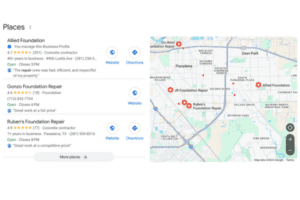Pretty much everything you could ever need or want has reviews posted online about it. That restaurant you wanted to visit? That movie you wanted to see? That show you wanted to watch? That new phone you wanted to buy? That hotel you wanted to book for your next company event? That pet bed you were eyeing for your dog? I’ll bet you money they have reviews somewhere online.
Google any of them and multiple options will pop up, where you can read through reviews and other people’s experiences. You will be able to get the information you need at the click of a button or the tap of a screen.
The same goes for your brand.
All a potential client or customer has to do is google your brand and everything they need to see is right there at their fingertips: your Facebook, your Twitter, your LinkedIn, anywhere your brand has made itself available online.
Through online websites and social media, word of mouth about anything is readily available and helps a client or a customer decide where they’re going to eat, what they’re going to watch, what phone they’re going to invest in, what hotel they’re going to stay at, and even what pet bed to buy for their animal.
It also helps them decide whether or not they want to do business with your brand.
Consumers and Online Reviews
Within the past year and a half, Podium conducted and posted a survey showing that 93% of consumers that look up online reviews say that what they read impacts the decisions they make about where their money goes.
When the next potential consumer clicks on any of the pages from their Google search, they’ll be able to read through reviews of your product or your service and the experience they had with members of your staff that represent your brand.
If your customer service processes are being done and your standards are being upheld, your next potential consumer will get to read about how well they were treated and how much they enjoyed working with whoever they came across as the face of your brand. These reviews will help sway the potential consumer reading the review. Hopefully, they will decide that doing business with your brand will be a good idea because they will be treated well.
As humans, there’s bound to be a day where you’re doing your best, but a slip of the tongue happens, or you don’t get to the customer as quickly as they would like, or the day is off all the way around. The voice of the consumer that had a bad experience with your brand will be at your potential customer’s fingertips as well. They’ll be able to see how your customer service processes failed the unsatisfied consumer and how the standards they expected the brand to uphold were not met.
The consumer will have to weigh the reviews they read and decide which consumer they want to believe. Do they believe the satisfied consumer? Or do they take caution to avoid an experience like the unsatisfied consumer?
What Can You Do?
There are a couple ways you can help the customer make up their mind over which review they are going to choose to listen to about your brand.
1) Answer the negative review
Always make sure to answer all online reviews – good OR bad! Express that you empathize with their experience. Apologize if it is necessary. This is very important. It is especially important to have a public response. When your potential customer is perusing reviews, and they see you followed up with a negative review, it shows you cared to make it right. That’s a step in the right direction. To top it off, you will be surprised how many people are willing to change a bad review if you resolve their issue.
2) Work to ensure brand standards are being upheld
Ensure that every person that acts as a face for your brand and comes into contact with your consumers understands the standards you require and that they have been followed to ensure every customer gets the same level of consistent service. Make sure they all know what the customer service procedures are and what steps to take to ensure that they are living up to brand standards.
If you notice that someone has started to fall below standards, speak up and coach them to get back up to par with what is required of them. If anyone has questions about your procedures and standards, be sure to answer them to give them clarity about what you expect. The more your associates understand, the more they can help to ensure your consumer receives satisfactory service that they can later write about when they go to post their online review of their experience.
Consider having a Standard Procedures Guide, to make sure every team member has access to this information.
3) Accept that not every day is perfect and take accountability for those left unsatisfied
Not every day with your brand is going to go just as it should; people involved with your brand are going to make mistakes with consumers. You will make mistakes along the way with consumers as well. It happens; humans make mistakes. Even a computer system makes mistakes and breaks down along the way. There’s going to be that consumer that has a bad experience and posts about it online for everyone to see.
You have to accept that and take action.
Pay attention to social media and review sites and work to resolve the experience 

How you solve the issue, and the customer service experience you provide in trying to rectify the bad experience will then be seen by others who look through your Facebook, Twitter, LinkedIn, and anywhere the review has been posted. People will see that you’ve worked with the unsatisfied consumer. This will show to prospective consumers that you value customer service, customer satisfaction, and the customer’s voice.
If you can rectify the unsatisfactory situation, it will show them that you will do what it takes to meet their expectations if they choose to do business with your brand, despite the initial lousy review.
In a world where the majority of consumers make decisions about nearly everything they invest their money into based on online reviews, every review and every customer experience posted online matters. But how you respond and handle the reviews and experiences becomes an asset to helping the consumer choose your brand out of the choices out there.
If you provide the type of customer service your consumers are looking for and are happy to write about, more will come.















